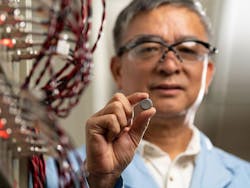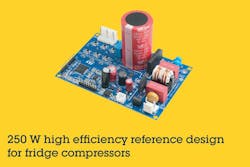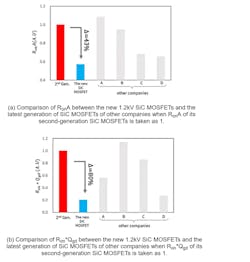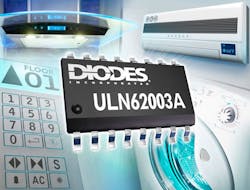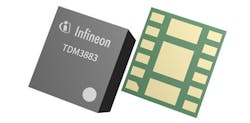This Week in PowerBites: A Summer Harvest of Innovative Power Products
This article is part of the This Week in PowerBites Library Series.
New Sodium-Based Battery Chemistry May Enable Low-Cost Cells to Compete with Li-Ion Storage Technologies
A research team from the Department of Energy’s Pacific Northwest National Laboratory has developed a sodium-ion battery with greatly extended longevity. As a result, it could become a low-cost alternative to the lithium-based chemistries used by most of the batteries in today's EVs, residential/grid-scale storage, and other applications.
Until now, the limited lifetimes and performance of today's sodium-ion batteries has hindered their commercialization for large-scale applications. The researcher's findings, described in the journal Nature Energy, provide a promising recipe for the liquid core of the battery. It eliminates many of the performance issues that have bedeviled sodium-based batteries until now.
“Here, we have shown in principle that sodium-ion batteries have the potential to be a long lasting and environmentally friendly battery technology,” said PNNL lead author Jiguang (Jason) Zhang, a pioneer of battery technologies.
The Right Salt
All previous sodium-ion battery chemistries have only been able to sustain a fraction of the charge/recharge cycles that lithium-ion, or even lead-acid, batteries can deliver. Nearly all commercially available batteries rely on a salt-based electrolyte solution to provide the charged ions that flow between the positive and negative electrodes.
While all of these batteries eventually lose capacity as a portion of their component materials become "trapped" and unable to return to their free state during charging, this degradation process happens much faster in the sodium-based chemistries available today.
The PNNL team, led by scientists Yan Jin and Phung Le, attacked that problem by creating a new electrolyte formula with a different salt, and liquid solvent. In laboratory tests, the new design proved durable, holding 90% of its cell capacity after 300 cycles at 4.2 V, which is higher than most sodium-ion batteries previously reported.
Production-Ready Motor-Drive Reference Designs Deliver 96%+ Efficiency
STMicroelectronics released two reference designs that simplify building complete industrial or home-appliance motor drives for compressors with the STSPIN32 motor-control system-in-package (SiP). Each integrates the motor controller with a three-phase inverter to power the motor, and an offline converter and auxiliary circuitry. The design also includes a production-ready PCB design and motor-control firmware.
The STEVAL-CTM011V1 targets general industrial compressors up to 250 W, while the STEVAL-CTM012V1 meets the stringent eco-design regulations for use in home appliances. The plug-and-play reference designs combine easily with a host system to start driving a motor and allow customers to fine-tune settings for optimal performance. Both ensure average efficiency greater than 96.5%.
At the heart of each design is ST’s STSPIN32F0601Q motor-control SiP, which contains an STM32F031 Arm Cortex-M0 microcontroller to customize the motor control to specific end application needs, as well as a rugged 600-V three-phase gate driver for the inverter. The firmware provided includes high-efficiency sensorless field-oriented control (FOC). The SiP is a compact and thermally efficient quad flat no-lead (QFN) device that meets high creepage requirements for safety and reliability.
The offline VIPER122 ac-dc converter integrates control logic with an 800-V avalanche-rugged power section. Frequency jittering prevents interference with other equipment, while inherently low power consumption and support for burst-mode operation at light load help comply with energy-saving regulations.
The inverter stage of the 250-W STEVAL-CTM011V1 reference design for industrial and general-purpose applications comprises six rugged STGD5H60DF insulated gate bipolar transistors (IGBTs). They’re engineered to maximize efficiency at high switching frequencies, allowing for smaller capacitive and magnetic components. In addition, their low package thermal resistance enhances reliability and tight parameter distribution assists safe paralleling in high-power applications.
The STEVAL-CTM012V1 home-appliance reference design contains six STPOWER STD8N60DM2 600-V, N-channel, MDmesh DM2 power MOSFETs. These are well-suited for high-efficiency converters, including zero-voltage-switching (ZVS) phase-shift converters, and combine high-speed, low-loss switching performance and low on-state losses.
The production-ready circuit-board design saves significant development time, avoiding complex layout and signal-routing challenges. The compact 11.2- × 7.5-cm board outline helps meet industrial and consumer-appliance form factors.
Both reference designs are available at the ST eSTore, priced from $47.78 for the STEVAL-CTM011V1 and $51.45 for the STEVAL-CTM012V1. The STSPIN32, VIPER122, IGBTs, and MOSFETs are in production now. For further information please visit www.st.com/STEVAL-CTM011V1.
Advanced SiC MOSFETs Offer Superior Reliability, On-Resistance, and Switching Losses
Toshiba's Electronic Devices & Storage Group's new series of SiC MOSFETs1 offer lower on-resistance and significantly reduced switching losses (roughly 20%). In addition to their exceptional performance, these devices address many of the reliability issues that have slowed the adoption and market growth of SiC devices until now.
The company addressed some of the issues that affect the reliability of these devices by placing a Schottky barrier diode (SBD) in parallel with the internal PN diode of the SiC MOSFET. However, inserting the SBD into the IC also increased the on-resistance per unit area (RonA) and high speed (Ron*Qgd), which degraded the MOSFET's performance unless the device's chip area was increased.
To overcome these hurdles, Toshiba developed a new device structure that reduces RonA by injecting nitrogen into the bottom of the wide p-type diffusion region (p-well) of the SiC MOSFET. The resulting structure enjoys lower spread resistance (Rspread)2 and increased SBD current. The JFET3 region also was reduced, and nitrogen was injected to lower feedback capacitance and JFET resistance. That, in turn, reduced the new structure's feedback capacitance without increasing RonA.
Prototypes of the new device structure confirmed that it lowers RonA by 43%,4 Ron*Qgd by 80%,5 and switching loss (from switching on and off) by about 20%,6 compared to its second-generation products. Stable operation without fluctuation of RonA also was secured by optimized positioning of the SBD.
Details of the achievement were reported at PCIM Europe 2022, an international conference of power devices held in Nuremberg, Germany and online on May 12.
Toshiba plans to start mass production of its third-generation SiC MOSFETs in late August this year (2022).
References
1. MOSFET: Metal-oxide-semiconductor field-effect transistor
2. Spread resistance: The diffusion resistance at the bottom of the p-well.
3. JFET: Junction field-effect transistor
4. Comparison of the new 1.2-kV SiC MOSFET when RonA is set to 1 in the second-generation SiC MOSFET. (Toshiba test results)
5. Comparison of the new 1.2-kV SiC MOSFET when Ron*Qgd is set to 1 in the second-generation SiC MOSFET. (Toshiba test results)
6. Comparison of the new 1.2-kV SiC MOSFET and the second-generation SiC MOSFET. (Toshiba test results)
"Smart" Buck Converter IC for USB Power Ports Features Adaptive Power Sharing
According to Silanna Semiconductor, it’s launched the world's first buck converter power IC to offer intelligent power sharing. The SZPL3002A buck converter with a built-in USB PD/FC port controller will significantly reduce the number of components needed to implement 65-W fast-charger and adapter applications with up to four ports.
The SZPL3002A delivers high power density and efficiency while reducing BOM costs by combining a high-efficiency synchronous buck converter and an advanced USB-PD port controller into a single QFN package measuring just 5 × 5 mm. Built on the company’s proven wide-voltage, high-frequency, point-of-load dc-dc converter technology, the converter operates with efficiencies in excess of 98%. Its integrated port controller offers full support for USB PD V3.0 Type-C interfaces and QC2.0/3.0/4.0/5.0 support for Type-A/C connections.
The converter's intelligent controller supports power sharing and port power re-balancing functionality across two, three, or four ports. It adapts to the needs of a particular device, irrespective of when connections are made. The device also provides protective power throttling, which automatically reduces current when temperature thresholds are reached.
The SZPL3002A's characteristics can be regulated using a fully programmable power contract set, which can be set by the manufacturer, or one of four, selectable pre-programmed power contract configurations that can be chosen with an external resistor value. Therefore, OEMs are able to use a single device across multiple product designs.
Key Features and Benefits
High-Efficiency (>98%) Synchronous Buck Converter
- Selectable Switching Frequency: 667kHz to 2MHz
- 3.3- to 21-V Output at 3.25 A (covers PD + PPS)
- 7- to 27-V Input
- 41-mΩ upper FET, 38-mΩ lower FET
- Selectable power-save mode, programmable soft-start times
- Full protection features such as OCP, OVP, OTP
- I2C bus for communication
- QFN 5- × 5-mm thermally enhanced package
Integrated Port Controller
- USB PD V3.0 Type-C port power supply supports QC2.0/3.0/4.0/5.0
- Calculated, adaptive intelligent power sharing across 2, 3, or 4 ports
- Port power re-balancing, power throttling at elevated temperature
- Integrated VCONN power supply
- 5 power profiles (resistor-selectable)
SZPL3002A devices are being sampled to key accounts and will be fully released in the second half of 2022. More information is available at https://www.powerdensity.com or by contacting [email protected].
7-Channel DMOS Transistor Array Drives Inductive Loads While Dissipating Minimal Power
Diodes Inc. recently introduced the ULN62003A, a new transistor array that consists of seven 500-mA-rated open-drain transistors, with all of their sources connected to a common ground pin. Capable of driving a wide variety of loads, such as solenoids, relays, dc motors, and LED displays, this high-current transistor array is aimed at climate control and home-appliance designs such as washing machines, dryers, microwave ovens, and air-conditioning units.
Fabricated with DMOSFET output transistors, the ULN62003A has an output voltage drop of just 0.2 V. This is far lower than the bipolar devices with which it’s pin-compatible. The resulting power-dissipation reduction not only minimizes overall power usage, but also mitigates thermal issues and improves reliability. Furthermore, it allows more devices to be controlled while still maintaining the desired die temperature.
In addition, the device's ability to support input voltages down to −1 V offers greater design flexibility and allows the GND pin to be used to detect overcurrent situations. This capability further increases system robustness and broadens the applications that the ULN62003A can address. Clamping diodes are included on each of this transistor array’s outputs for protection and improved reliability when driving inductive loads.
The ULN62003A comes in a SO-16 package and offers superior performance when compared to many popular peripheral driver devices, according to the company. It costs $0.25 in 1,000-piece quantities.
Advanced Trench-Gate Field-Stop IGBTs Provide Low Conduction/Switching Loss
Bourns Inc. entered the insulated-gate bipolar transistor (IGBT) market with its first high-efficiency 600-/650-V discrete product line co-packaged with a fast recovery diode (FRD). Designed using advanced trench-gate field-stop technology that provides greater control of dynamic characteristics, the five new Bourns Model BID Series discrete IGBTs deliver lower collector-emitter saturation voltage (VCE(sat)) and lower switching losses compared to previous-generation non-punch-through IGBTs.
In addition, this structure offers a positive temperature coefficient that helps increase device longevity and reduce power requirements in high-voltage and high-current designs.
The new IGBTs are available in thermally efficient TO-252, TO-247 and TO-247N packages which maintain a lower thermal resistance (Rth(j-c)) for cooler-running switch-mode power supplies (SMPS), uninterruptible power sources (UPS), induction heating, and power-factor-correction (PFC) applications. Offering four voltage/current model options (600 V/5 A, 600 V/20 A, 600 V/30 A, and 650 V/50 A), Bourns BID Series discrete IGBTs have been tested and qualified according to JEDEC standards for power switching products.
Bourns BID Series IGBTs are available now and are RoHS-compliant and halogen-free. For more detailed product series information, visit www.bourns.com/products/igbt.
Efficient IPOL DC-DC Buck Regulator Modules with Integrated Inductor Simplify Compact Designs
A series of high-efficiency, reliable step-down dc-dc converter modules developed by Infineon Technologies enable compact designs for point-of-load (POL) supplies that can be brought to market quickly to address many space and thermally constrained applications. Such applications for these fully integrated modules include telecom/datacom equipment, servers, and network storage.
TDM3883 and 3885 IPOLs (integrated POL) are fully integrated single-output buck converters, offering a continuous 3-A/4-A load capability with line regulation over a wide input supply range (4.5 to 14 V). Their integrated inductor and capacitors simplify the design process by reducing external components and enable designs with much higher power density.
POL supplies based on these modules minimize the PCB wiring trace required to implement them, resulting in low parasitic parameters that offer improved performance over discrete solutions. In addition, their small footprint allows the modules to fit into restricted PCB space, enabling customers to develop more compact designs (up to 80% space savings over discrete solutions).
Both modules feature a low supply current (10 μA) at shutdown, resulting in longer battery life for portable applications. Also, due to their tight reference voltage (VREF) tolerance (0.5 V ±1.0%) and low ripple, they provide accurate power delivery and contribute to system stability and reliability.
To further support this, they employ an Enhanced Stability COT (constant on-time) engine that uses integrated ceramic capacitors and doesn’t require external compensation. They also can be configured to support a forced continuous conduction mode (FCCM).
In addition, the modules come with thermally compensated, internal overcurrent protection (OCP); enhanced light load efficiency with reduced switching frequency; and diode emulation mode (DEM). With ultra-light loads, they can enter a low quiescent-current mode, making it ideal for standby power supplies. Other features include internal soft-start, enable input, pre-bias startup, thermal shutdown, a power-good output, overvoltage protection (OVP), and UVLO.
Manufacturers also can enjoy reduced production costs because the modules' converter chip, integrated inductor, and capacitors are extensively tested to ensure reliability and a positive final test (FT). This eliminates the need for separate selection and test of the passive components.
Availability
The TDM3883 and TDM3885 integrated POL buck regulator modules with integrated inductor are available in a 2.7- × 3.1- × 2.3-mm3 PG-LGA-15-1 package and a 3.1- × 3.8- × 2.3-mm3 PG-LGA-15-2, respectively. More information, including links to device specifications, can be found at Integrated POL Voltage Regulators - Infineon Technologies. Additional information about the company’s contribution to energy efficiency is at www.infineon.com/green-energy.
24-V MOSFET for Wireless Earphone Batteries Features Advanced Protection
Magnachip Semiconductor unveiled a new 24-V MOSFET that’s specifically optimized for wireless earphone batteries. The device’s reduced conduction loss can help battery designers extend their product’s long battery life after a quick charge. In addition, this new product's core cell density is 30% better than the previous version, while the design of the core cell, termination, and source pads has been enhanced to reduce the RDS(on) by 24% (RDS(on) = on-resistance, the resistance value between the drain and the source of MOSFETs during on-state operation).
These improvements significantly reduce conduction loss while charging and discharging as well as boost the overall efficiency of battery-protection circuits. In addition, this 24-V MOSFET can help extend the service life of earphone batteries with robust protection against supply voltages above 5 V and against electrostatic discharge (ESD) of up to 2 kV.
Read more articles in the This Week in PowerBites Library Series.

